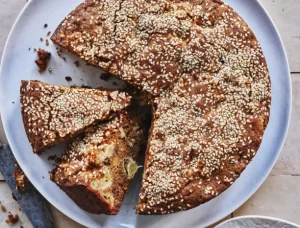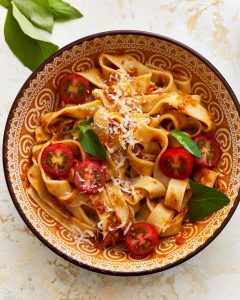September 20, 2024 / Lyn Jones / 0 Comments
You won’t easily forget this, the Greek Orthodox cake “for lost things”. A little patience pays off: make this cake a day ahead to allow it to settle into a pleasingly dense and moist crumb.

Ingredients
zest and juice (60ml) of 1 large orange
100g sultanas
250g caster sugar
220ml light olive oil
2 large eggs
290g plain flour
1 tsp BP
½ tsp bicarb
1 tsp ground cinnamon
¼ tsp ground cloves
¼ tsp fine sea salt
2 apples, peeled, cored and cut into 1-2cm dice
100g toasted walnuts, roughly chopped
15g sesame seeds
Step 1
Line the base and sides of a 23cm round tin with baking paper and preheat the oven to 165C FF.
Toast walnuts, prepare apples & orange.
Step 2
Combine the orange juice & sultanas in a small mixing bowl and leave to macerate.
Step 3
Place the sugar & orange zest in a large mixing bowl and rub firmly between your thumbs and fingers for a couple of minutes to release the fragrant citrus oil. Add the olive oil and whisk well until the mixture turns opaque, then add the eggs one at a time, whisking well to combine.
Step 4
Combine the flour, BP, bicarb, cinnamon, cloves & salt in a bowl, then sift into the egg & oil mixture. Add the apple, walnuts & sultanas (incl orange juice) and mix tog til combined.
Step 5
Scrape batter into prepared tin, then scatter sesame seeds over the top.
Bake for 60-70 mins, or until a skewer inserted into the centre of the cake comes out clean.
Step 6
Remove cake from the oven and onto a wire rack to cool completely. Turn out of the tin and cover with a plate or kitchen foil and leave for 24 hours before eating!!
September 15, 2024 / Lyn Jones / 0 Comments
This homemade almond flour pasta is nutritious & delicious! It cooks perfectly al dente and holds up well against heavy sauces and toppings. It makes a pliable dough that rolls out great—even if you don’t have a pasta machine. Then, when cooked, the pasta is silky smooth with a satisfying chewy texture. Packed with protein & naturally GF, grain-free & DF. You don’t know what you’re missing until you try it for yourself! Serves 1

Ingredients
1 cup almond flour
1 teaspoon xanthan gum (adds elasticity)
¾ cup tapioca starch* (or arrowroot or potato starch in a 1:1 ratio)
½ tsp salt
3 large eggs
2 Tab water
1 Tab olive oil
1. In a large mixing bowl, whisk together the almond flour, tapioca starch, xanthan gum & salt until well combined. Create a well in the centre of the drys. Crack the eggs into the well & add the water and olive oil. Using a fork, gradually incorporate the drys into the wets, mixing until a shaggy dough forms.
2. Turn dough onto a clean work surface & knead 2-3 mins til it becomes a smooth, pliable ball.
If too dry, add 1t water at a time until it reaches the desired consistency. Cover with plastic wrap and let it rest for 30 minutes.
3. Divide dough into 4 equal pieces. Working with one piece at a time (cover the rest) & with a rolling pin, roll dough into thin sheets approx ⅛ inch thick. Cut into desired pasta shapes using a knife or a pasta cutter. **
4. To cook the fresh almond flour pasta, bring a large pot of salted water to a rolling boil. Add the pasta and cook for 2 minutes, or until the pasta floats to the surface and is al dente.
Drain the cooked pasta and toss it with your favorite sauce or toppings. Serve hot and enjoy.
NOTES:
* Use fine, blanched almond flour, not almond meal.
Make the pasta dough ahead of time by storing in an airtight container in the fridge for up to 2 days.
Dry the pasta on a drying rack or lay flat on a floured surface overnight. Store in an airtight container for up to 2 weeks. Cook the dried pasta for 5-6 minutes until done.
To Store: The cooked pasta keeps well in the fridge for up to 3 days. Refrigerate the uncooked pasta dough for up to 2 days. Always wrap in plastic wrap or store in an airtight container for freshness.
To Freeze: Shape the pasta dough and lay each piece on in a single layer on a baking sheet. Freeze until solid and then store in an freezer-safe container for up to 3 months. Cook the pasta from frozen for 3-4 minutes.
Nutrition: Sodium: 360mg Potassium: 53mg Protein: 10g
Tips and Suggestions
The dough will seem lumpy at first, but it’ll get smoother as you knead it. And don’t worry about overworking the dough—there’s no gluten to toughen it up!
If your dough seems a little dry during the kneading process, add a teaspoon of water at a time until it looks and feels smoother.
Don’t forget to let the dough rest for at least 30 minutes before rolling it out. This will allow the ingredients to fully come together and create a more pliable dough.
Lay the pasta dough on parchment paper while rolling it out to prevent sticking.
You can shape the pasta in any way you prefer! Cut it into thin noodles as I have, make ravioli, or even shape it into gnocchi-like dumplings.
Be careful not to overcook the pasta! Fresh pasta cooks much quicker than dried.
Make this recipe for almond flour pasta ahead of time and store the dough in the refrigerator for up to 2 days. Wrap it tightly in plastic wrap or place it in an airtight container before refrigerating.
Can I Dry Almond Flour Pasta?
You can! Hang the pasta on a pasta drying rack or arrange it flat on a lightly floured surface. Allow the pasta to dry completely for several hours or overnight, then store it in an airtight container in a cool, dry place for up to 2 weeks. Dried pasta should be cooked for about 5-6 minutes until al dente.
Here are some of my favorite ways to serve it:
Topped with pesto, tomatoes, and fresh basil
Piled high with gluten-free meatballs or spaghetti sauce
Mixed with sautéed veggies and gluten-free Alfredo sauce
Cold in a creamy Italian pasta salad (cook the pasta first, then cool it)
Tossed with garlic, olive oil, and grilled shrimp or chicken
Alongside warm gluten-free garlic bread
Storage Instructions
Cooked almond flour noodles can be stored in the fridge in an airtight container for up to 3 days. You can also store the uncooked almond flour pasta dough in the fridge for up to 2 days or freeze it for up to 3 months. Arrange the cut pasta in a single layer on a baking sheet, freeze until solid, and transfer to a freezer-safe bag. Cook the pasta from frozen by adding a minute or two to the cooking time.

